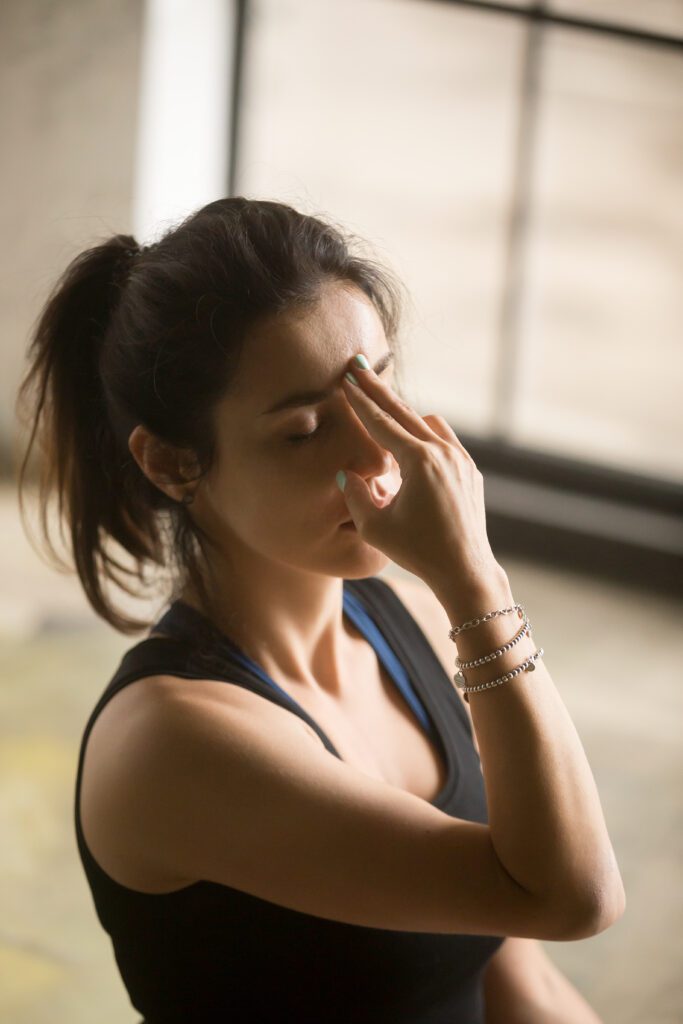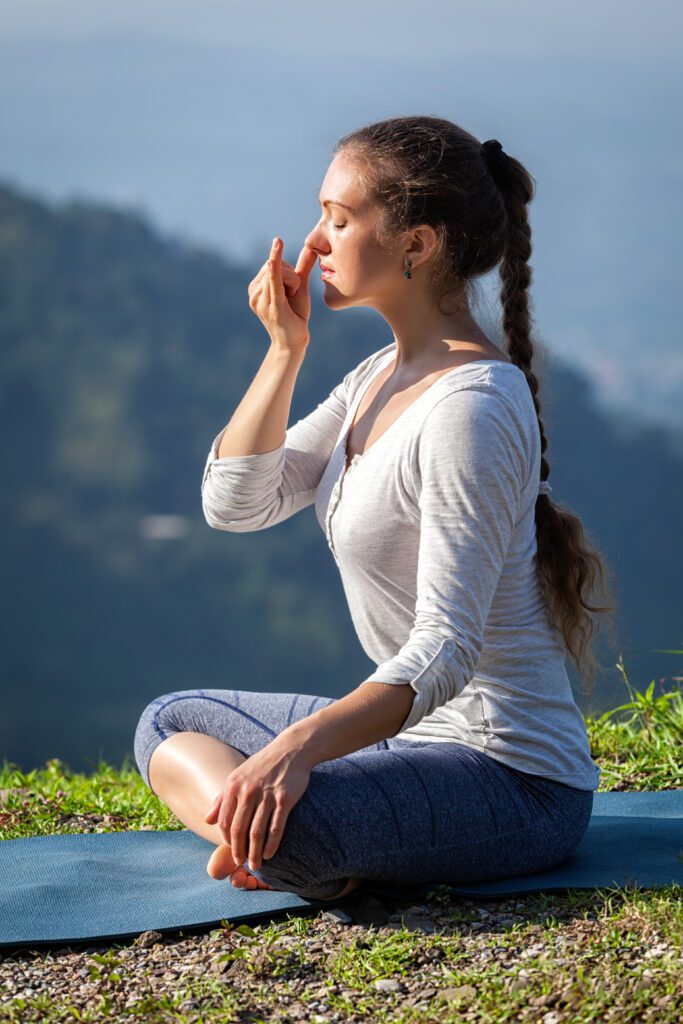Week 2: Breathwork
-
A Deeper Dive
Pranayama full meaning is control of life force our breath.
Broken down Prana= life force (breath) and yama (to control).
The breath acts as a bridge to our nervous system and by exploring pranayama practices we can observe how deeply it is connected to the mind.
Breathwork taps into our parasympathetic system known as rets and digest. It is impossible for us to be in a state of fight or flight (sympathetic nervous system) when we are in control of our breath.
Improves our lung capacity and helps to clear one of our most vital organs our lungs.
“When we control our breath, we control our life”.
— Melody Beattie


Nadi’s mean energy channels. Sodhana meaning purification and cleansing. So, the object of this pranayama is to purify the nervous system and allow optimal flow of prana.
This practice balances the flow of energy between the left and right sides of the body. It is especially beneficial when you need to re-centre yourself and is useful in leading you into meditation.
This video will take you through how to perform alternate nostril breathing.
Nadi Sodhana (alternate nostril) breathing:
Bhramari Breath (Bumble bee):
Listening inwardly to the sound of our own breath is deeply restorative. This practice calms the emotions. It relieves anger or anxiety because it reconnects us to the nurturing rhythmic pulsation within our own being.
Regular practice instantly increases our sense of wellbeing.
Used for anxiety, helps memory and concentration, relieves tension in head therefore good for headache sufferers. Can help to decrease anger and irritability.
This video will take you through the steps of Bhramari humming bee breath.
Ujjayi Pranayama is good to use throughout your asana (movement) practice.
Ujjayi means “victorious” or “expanding.”
In this pranayama, the breath is kept high up in the chest, rather than being allowed down into the abdomen. The chest is therefore puffed up, hence the name.
This video helps to break down the inhale and the exhale of Ujjayi breath.
It helps to get focused and build energy.
Relieves insomnia therefore it is great to do just before sleep.
It also helps to decrease your heart rate.
Ujjayi Breath (oceanic):
The Power of Breath
"If you want to conquer the anxiety of life, live in the moment, live in the breath."
— Amit Ray
- 1. Stress Reduction: Deep, intentional breathwork triggers your body's relaxation response, calming your nervous system and reducing stress and anxiety.
- 2. Mindful Awareness: By focusing on your breath, you anchor yourself in the present, cultivating mindfulness and presence in your daily life.
- 3. Emotional Regulation: Breathwork empowers you to navigate your emotions, promoting emotional intelligence and resilience.
- 4. Benefit the immune system: by purifying and cleansing the toxins through breath exchange.
- 5. Relieve anxiety & depression: when we breath better, we feel better.
- 6. Enhance brain function: increases mental focus, calmness & recovery from stressful stimuli.
- 7. Enhanced Vitality: Oxygenating your body through mindful breath invigorates you, promoting physical health and wellbeing.
Breathwork Techniques
-
1. Bhramari (Bumble Bee) breath: this is a breath used to calm the central nervous system and allow to drop into a state of relaxation. Using a gentle humming sound for the out breath through closed lips. Performed breathing through both nostrils and lips sealed we hum out our exhale (Naturally the air sips out the nose).
Babies use this when they are trying to go to sleep , you often hear them humming noise to soothe themselves off to sleep. This is a primordial sound and an innate knowing to calm the nervous system. -
2. Ujjayi Breath (oceanic sound)
This is a breath used that is audible and sounds like the waves of the ocean. Calming and soothing yet also warming and energising and balancing.
This breath is performed with our mouth closed, in through nose and out through the nose. We constrict the back of out throat when doing this breath. The out breath is what you would do when fogging up the mirror but with lips sealed. The in breath is like what you do when you yawn but again with lips closed. Audibly hear a rasping sound. Alternate -
3. Alternate nostril breathing (known as Nadi Sodhana):
Close your right nostril with your right thumb. Inhale deeply through your left nostril. Close your left nostril with your right index finger and release your right nostril. Exhale through your right nostril. Inhale through your right nostril, close it, and exhale through your left nostril. This is one cycle; repeat for several cycles. -
4. Transformation: Practicing gratitude can lead to profound shifts in consciousness, helping individuals experience a sense of transcendence and inner peace.
Help to balance left and right hemisphere of the brain. Balance yin/yang energy. Male /female energy, sun /moon (known as ida/pingala). Creates balance and homeostasis within the body. Grounding affect.

Breathwork How To Guide
Here's a step-by-step guide to practicing Breathwork:
- 1. Find a Quiet Space: Choose a quiet, comfortable place to sit or lie down. You can use a cushion or chair for added comfort.
- 2. Relax Your Body: Close your eyes and take a few natural breaths to settle in. Relax your body, starting from your toes and working your way up to your head.
- 3. Begin Your Breathwork: Choose a technique from the options above or experiment with different ones. Start slowly and gently, without straining.
- 4. Focus on Your Breath: Concentrate on your breath, paying attention to the sensations as you inhale and exhale. Be aware of the rise and fall of your abdomen or the flow of air through your nostrils.
- 5. Stay Present: If your mind starts to wander, gently bring your focus back to your breath. Use prompts like "Inhale peace, exhale tension" or "Breathing in, I am here; breathing out, I am free."
- 6. Set a Timer: Practice for 5 to 20 minutes, depending on your comfort level and experience.
- 7. End Mindfully: When you're ready, slowly return to your natural breath. Take a moment to acknowledge how you feel.
Prompts for Breathwork Practice
As you engage in breathwork, consider these prompts to guide your experience:
- “What does my breath feel like today?”
- “With each breath, I release tension and find peace.”
- “As I inhale, I am filled with gratitude; as I exhale, I let go of worry.”
Remember, breathwork is a personal journey, and there’s no right or wrong way to do it. It’s about connecting with yourself, finding stillness, and experiencing the benefits of mindfulness. Practice regularly and embrace the peace that breathwork can bring to your life.